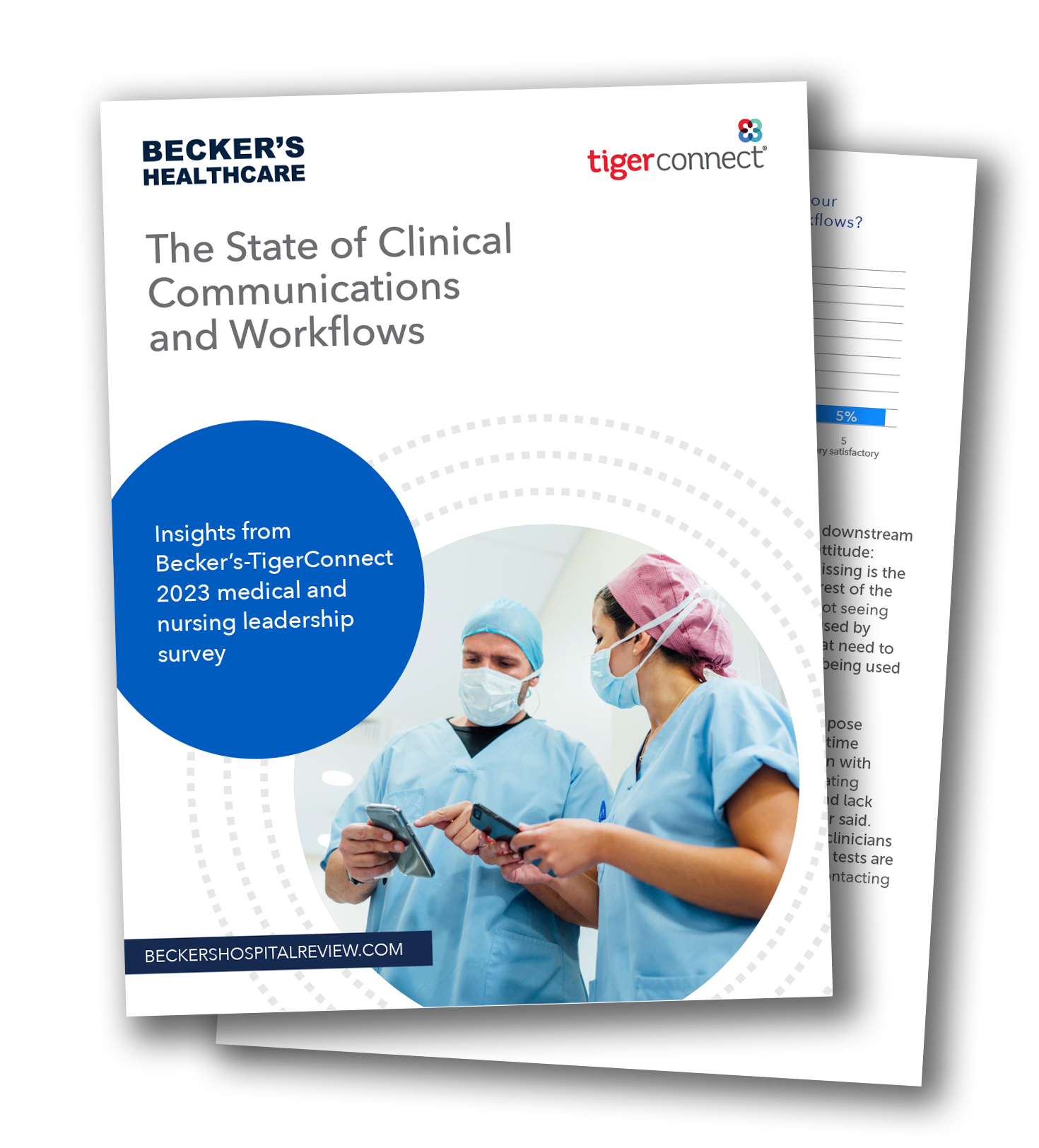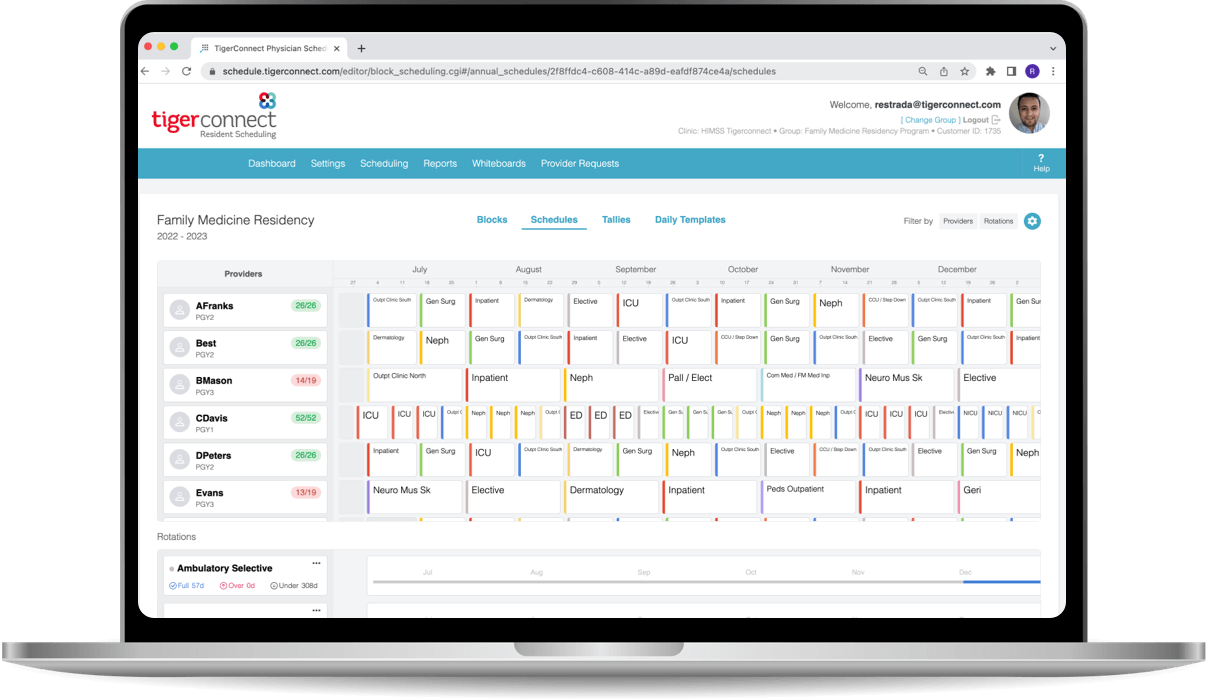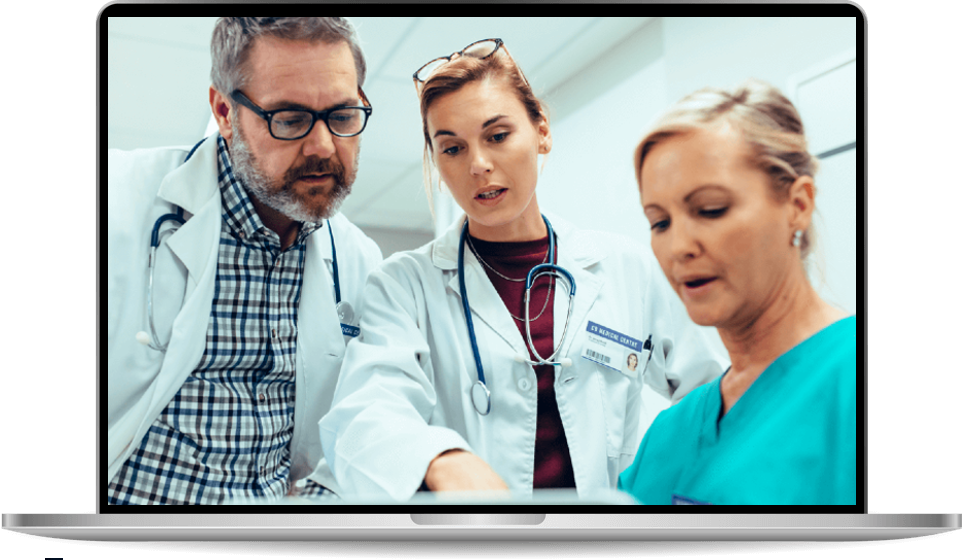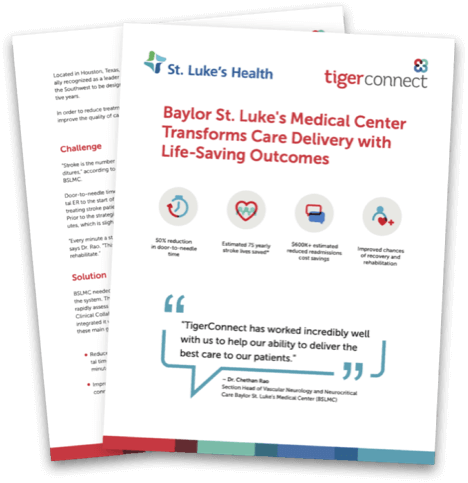0:00:01.4 Dr. Russ Kino: It’s simple and easy to use, which really is the number one criteria, because if it’s not simple and easy and intuitive, people aren’t gonna use it.
[music]
0:00:17.9 MaryAnn Borer: Hi, I’m Mary Ann Borer with HIMSS. Today, I’m joined by Dr. Russ Kino, Medical Director of Emergency Services and Chief Medical Informatics Officer at Providence Saint John’s Health Center and Dr. Will O’Connor, Chief Medical Information Officer at TigerConnect, and today our topic is Efficiency Meets Excellence: A Spotlight on Providence Saint John’s Health Center. Before we start, I wanna say thank you to TigerConnect for sponsoring this podcast. Providence Saint John’s is a nationally renowned 256-bed hospital with physicians, nurses, volunteers and support staff who work as a team to provide the best possible medical care to its patients and the community. TigerConnect transforms healthcare with the industry’s most widely adopted clinical collaboration platform, uniquely modernizing how doctors, nurses, care teams, patients and data connect. With a comprehensive range of solutions, including Care communication and patient engagement, scheduling, alarm notifications, nurse call and more, TigerConnect enhances efficiency, lowers expenses and ensure safe reliable communication. Dr. Kino, Dr. O’Connor, thank you joining us today.
0:01:36.1 Dr. Will O’Connor: Thanks for having us.
0:01:37.0 RK: Pleasure.
0:01:38.7 MB: Dr. Kino, could you please tell us about your role at Providence Saint John’s Health Center, and your experience in healthcare informatics and emergency medicine?
0:01:48.9 RK: Sure, thank you. So currently, I’m the director of the emergency department and also CMIO for the hospital. I also function in the Providence system on the Emergency Medicine Steering Committee, and they’re very focused on efficiency and throughput across all of our 52 hospitals across the western U.S. for Providence. So my focus is very much looking at hospital efficiency, not just in the emergency department, but house-wide and TigerConnect has been extremely helpful and pivotal in our improvement of our throughput processes.
0:02:31.5 MB: Fantastic. Dr. Kino can you describe some of the communication challenges that care teams face in the emergency department?
0:02:39.5 RK: One of the reasons we adopted TigerConnect in the first place is because we had many doctors requesting multiple ways to be contacted when they’re on our call panel. So we have 23 call panels for our emergency department covering nearly all specialties, and over the years, they had wanted various ways of being called and with the use of cell phones, some people wanna be texted, some wanna be called on the cell phone, some wanted to be called through their offices, and it was becoming practically impossible for our associates to do all the phone calls out of the emergency department to remember who wanted to be contacted which way. So we decided to bring in one standardized platform for communication for all of our physicians, all of our caregivers, our nurses and ancillary staff as well. And what we wanted is a system where we didn’t have to make phone calls because as everybody knows, when you make a phone call to a consultant from the emergency department, invariably, they’re busy seeing a patient or doing a procedure, so you leave a message and then they call back, and when they call you back, you’re in with the patient. So trying to have a synchronous conversation is really impractical without workflow.
0:04:07.2 RK: So we were looking for an asynchronous method of communication so we could leave each other messages and pick them up when it suited us, and obviously text messaging fit the bill for that. We wanted our text messaging to be HIPAA compliant, and so we also wanted to integrate with other functions like scheduling, which I’ll get to in a moment, but TigerConnect really fit the bill for us in that department and in all of those ways. And so we set up an agreement with TigerConnect and the benefits have been really quite remarkable, apart from the asynchronous communication, the HIPAA compliant method through which we text, we’re also very happy that we have the auto-delete functionality, so all of these messages, we’ve chosen to only keep them for 10 days and then auto-delete them so that they’re not discoverable after 10 days.
0:05:15.2 RK: It’s really great, we’re able to send images of EKGs or patients because it’s all HIPAA compliant, we have a read receipt, so we know if the recipient has seen it and if they’ve read it, we can set up groups around patient care, we have broadcast. Although there’s other forms of text communication like Epic Chat, this is really a best of breed, it’s way easier to use than Epic Chat and it can’t be used against you, it’s not discoverable, as I said, because we’ve chosen to auto-delete. And then the other really huge benefit for us is that it integrates with a calendar function, so we’ve also put all of our call panels onto the Tiger schedule, and so all about 23 call panels, which is like 400 physicians are on this Tiger schedule, and that integrates with the text messaging. And by the way, you’re not limited just to text messaging, you can also make a video chat or a phone call, and the lovely thing about it is you don’t need to know anybody’s number.
0:06:32.8 RK: So everybody on our medical staff is entered into a directory, you pull them up by name, and call them without knowing people’s numbers, so it really is seamless and efficient. We love the fact that it’s integrated with the calendar is really helpful, because we can look up who’s on call on any given day, and then you can text or call them HIPAA compliantly straight out of the call schedule. And then for the doctors who are on call, they can just switch call remotely on their phones with each other by swapping in and swapping out of a role. So we’ve really had tremendous benefit from using it.
0:07:21.0 MB: Dr. Kino how does the clinical communication and collaboration platform help drive efficiency and streamline processes, and how does that benefit patient care?
0:07:31.0 RK: When you have a patient… We all know the struggle getting patients admitted, getting them move through the continuum of care in the hospital, which may mean upgrading or downgrading out of various units, and then obviously discharging the patient. As we all get busier with more and more pressure on us and to maintain the bottom line, we need to be more efficient. An amazing thing about efficiency for hospitals is that efficiency really underscores safety. If you’ve got unstable sepsis patients, the quicker you get to them, the quicker you get them admitted to the ICU, the quicker you get their fluids and antibiotics and presses moving, the better their outcomes. And so safety and quality is really based in efficiency. Also patients wanna be cared for quickly, so patient satisfaction is also heavily connected with moving the patients efficiently, and obviously the hospital’s bottom line. So you’ve got safety, quality, patient satisfaction, and financial issues with the hospital’s bottom line all aligned with moving patients through the continuum of care from admission to discharge more efficiently.
0:08:55.7 RK: So being able to communicate quickly and asynchronously speeds up getting patients admitted out of the emergency department, being able to send an EKG image HIPAA compliantly to a cardiologist for an acute MI really improves care. Same with our sepsis and stroke teams we are also able to use TigerConnect to contact them 24/7 and improve the speed with which we initiate care and get them admitted. And the same thing happens at every juncture throughout the continuum where you need to get patients moved from one unit to another, or discharged from the hospital. For example, with a discharge, we’re able to set up a team around moving a patient out of the hospital, so for example, we’re able to troubleshoot roadblocks with getting medications or getting the durable medical equipment set up or getting the admission to a skilled nursing facility et cetera. So at every junction, communication and the ability to speed it up and tighten it and know that people are reading your messages and acknowledging you and being able to troubleshoot problems and bottlenecks really has helped us cut our length of stay. So we were able to cut our length of stay by about 20% from doing this.
0:10:32.0 RK: So the impact to the hospital’s bottom line just from that alone was enormous, never mind the safety, quality and patient satisfaction improvements that we recognized from it as well.
0:10:46.2 MB: Dr. Kino can you share any specific instances where TigerConnect has made a significant difference in efficiency or communication within your emergency department?
0:10:56.0 RK: The three most time-sensitive management issues that happen to us every day. Closely, we’re a comprehensive stroke center and STEMI receiving center, and we have a very large elderly Medicare population. So having told you that, all of the listeners would know we get a lot of stroke, a lot of MIs and a lot of sepsis every day. And so it’s really around those three things that speed is of the essence and determines the outcomes of many of these patients as they say, “Time is brain,” or “Time is muscle,” with the heart, and time is everything with sepsis. So these are the three areas where we rely on TigerConnect the most, so the fact that we have all of these specialists that we call, whether it’s our interventional cardiology team, interventional stroke team, or our ICU team for sepsis, we are able to contact them all immediately. Our unit secretaries are able to put out a text message to all three through their desktop application, or our emergency physicians can text them to the Tiger app on their phone and get an immediate response. And for example, actually our interventional cardiology team has requested that before we even send them any kind of message, the first thing they want is an image of the EKG showing as STEMI, ST Segment Elevation Myocardial Infarction.
0:12:44.7 RK: So they want us to take a picture with our phone of the EKG, text it to them, so it’s in front of them, then call them and give them the clinical story, and then they can make a rapid determination whether the patient is going to the cath lab, et cetera. So it’s really sped things up and like I said, safety, quality, satisfaction and the bottom line all aligned and improved once you speed care up by using a communication platform like Tiger that integrate everything, and actually I think there’s some exciting things ahead that we’re working on with getting reports out of Epic that will further cue us even earlier into making management and disposition decisions.
0:13:38.8 MB: Well, that sounds terrific. Dr. Kino, one more question. For other health care professionals and informatics individuals, what advice would you give them when considering implementing a communication platform like TigerConnect?
0:13:53.4 RK: I don’t think there’s too many competitors out there for this product. I think Tiger is the best of breed, it’s simple and easy to use, which really is the number one criteria, because if it’s not simple and easy and intuitive, people aren’t gonna it. So I would say that’s really the first thing that it’s intuitive, it’s really easy to use, no different from any other kind of texting, and then all the other features that I mentioned before, the asynchronous communication, the HIPAA compliance is huge, whatever you use, it’s gotta be compliant. You would want an auto-delete function for sure because of the medical malpractice issues surrounding communication. You wanna be able to send images, you wanna read receipt, you wanna be able to do groups and broadcast, and you really want the integration with a calendar function, so that you could have all of your specialists, who are on call on the same platform, able to swipe in and out, so you could look up who’s on call for any specialty and text them instantly out of the app. So it’s just one-stop shopping. It’s super intuitive.
0:15:13.4 RK: And the other thing I’d say about Tiger is they have a track record that’s unequal, really. I think they’ve got several thousand hospitals in the country that are using the product, and they’re constantly innovating, and like I said, I think there’s some exciting stuff that I’m looking forward to getting a hold of that we could use to further improve. So I think Tiger is not just a communications platform, they’re very focused on throughput and patient flow, and to me, that’s huge because my whole focus is hospital-wide flow, and that is probably one of the biggest benefits that Tiger is not just the communications platform, but it’s an application for improving efficiency and flow of patients through the continuum of care in a hospital. So I think that’s probably the biggest attribute.
0:16:15.0 MB: Wonderful, thank you so much. And Dr. O’Connor, I have just a few questions for you as well. Can you tell us about your role and your experience as a physician in helping healthcare organizations improve their communication and workflows?
0:16:29.0 WO: Well, I am Chief Medical Information Officer at TigerConnect, and I’ve been doing this for several years now, and the experience has really been interesting. When I typically go in and help a healthcare organization with their communication and with workflow, what we typically find is something that’s disjointed, something that’s not necessarily connected, something that’s inefficient, something that’s probably not mandated, and you have several factions around the organization using different methods to communicate and collaborate with each other, and what that leads to is inefficiency of care, longer length of stay, and a negative impact on quality and safety. So that’s typically what I find at almost every organization that we go into before we install TigerConnect. And after we get to partner with that organization and install TigerConnect, we really do focus hard on exactly what Dr. Kino was talking about, making things faster, making them more efficient, because we know that when we do that, it leads to an improvement in quality and safety, it certainly leads to an improvement in cost, and ultimately it’s a much better experience for both the caregiver as well as the patient.
0:18:04.3 MB: Terrific. Now, Providence St. John’s utilizes TigerConnect in various departments beyond the clinical staff. How was the platform adapted to accommodate the diverse communication needs of these different hospital environments?
0:18:19.2 WO: Yeah, that’s a great question. We do find that every hospital is a little bit different, and really every department is a little bit different, and the key is having a tool that is flexible enough to be able to meet the needs of those specific departments, but then perhaps even more importantly, making sure that we’re connecting those departments with each other, that’s where we see a lot of roadblocks today in hospitals when we go in. Certain departments may communicate well together, but they’re not necessarily communicating well with other departments in order to deliver efficient patient care, and that’s really one of the great things about TigerConnect is the tool is flexible enough to meet these different workflows, but then connects them in a very holistic way across the organization, where it drives those improvements in cost, quality and experience of care.
0:19:14.3 MB: I see. Now one more question for you, Dr. Connor, what are the benefits of TigerConnect as independent tool from other clinical systems?
0:19:22.5 WO: It’s interesting, I think what we have found over time and what, just in general, the industry has found over time is communication and collaboration is a primary use case. Think about what you use to communicate with folks today, it’s typically iMessage or SMS or something, that is a primary use case for that application. This is really the same thing, and what we find is if you bury communication in an EMR or some other tool that’s doing dozens of other things, it drops your efficiency, people don’t access the tool as quickly and you don’t get the type of benefits that we are talking about here. So the benefits of doing this separately like TigerConnect does, you heard Dr. Kino mention a few of these things, they had a 20% reduction in length of stay, they’re seeing improvements in quality and safety relative to things like stroke, myocardial infarction and sepsis, so that’s really the benefit of having that independent tool.
0:20:26.3 WO: The other thing that it does is it allows people to communicate and allows care delivery to continue if some of these other systems are down, like an EHR or another system that you might try to communicate with. Having an independent standalone system that works all of the time, that is available in the Cloud, that doesn’t require the hospital infrastructure or the hospital network to run is really essential, and it’s one of the big benefits having TigerConnect function as an independent tool. And again, that’s where we’re really seeing all the improvement. Because it’s an independent tool, it’s so simple, it’s so easy to use, it makes everyone faster, it makes them more efficient, and again, that’s where we’re really seeing the benefit in terms of improvements in cost, quality and experience of care.
0:21:21.8 MB: Wonderful. Dr. Kino, Dr. O’Connor, thank you both so much for being here today and for joining us for your insights.
0:21:28.0 WO: Thank you.
0:21:29.2 RK: Thank you.
0:21:30.3 MB: And of course, special thanks TigerConnect for sponsoring this podcast. Have a fantastic rest of your day.
[music]












